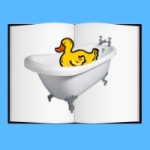
 |
Where Am I? |
In this interactive book for preschoolers we explore the concept of positional words. It introduces children to identifying where in their environment one object is in relation to another. It does this with delightful pictures, simple narration and also allows them to test their knowledge at the end of the book.
Children do not need to be able to read, as the sentences are read to them. They can have fun clicking on the speaker icons to have each one reread.
Pages can be turned forwards and backwards by clicking on the turned corner at the bottom of the pages. Children can also use click and drag in the direction of the arrow. This makes the reader feel like they are turning the page of a real book.
On turning the first page, children have a choice of four characters with whom to play: Doris the duck, Betty the doll, Rupert the dog and Trixie the monkey. As they turn the page, the sentence is read and their character is placed in the picture. On the last page children are asked to place their character in relation to another object.
To exit, click on the small hand in the upper right corner of the screen.
Outcome 1: Children have a strong sense of identity
Outcome 4: Children are involved and confident learners
Outcome 5: Children are effective communicators
Positional words
Decision making
Understand that print carries meaning
Enrich vocabulary
Relate images to text
Listening
Following instruction
Programme navigation
Mouse control - single click
Mouse control - click and drag
Learning positional words is an important part of preschool language development. This skill enables children to describe the world around them and effectively communicate with others. The ability to use these words properly allows them to follow and give instructions and understand their environment, becoming social beings in the process.
There are lots of positional words. We have used only a few in this activity (in, on, over, under, behind, in front of and beside). Here are some other words to add to the list: above, around, beginning, below, between, bottom, down, end, far, finish, inside, left, middle, near, next to, off, out, outside, right, start, top, through, up.
Here is a great game to play in a group. Each child can use a simple object. Ask them to follow simple directions. eg. "Hold the bean bag over your head. Stand beside the toy. Sit on the chair." Place an emphasis on the positional word/s in each sentence. Use as many different ones as possible. Another version is to ask children to describe where in the room something is. It may be on the wall, beside the paint pots, near the clock, in the bookshelf. There are lots of different possibilities. This gives them practice and develops confidence with their verbal communication.